Phenol Liquefaction of Waste Sawdust Pretreated by Sodium Hydroxide: Optimization of Parameters Using Response Surface Methodology
Abstract
:1. Introduction
2. Results and Discussion
2.1. Alkali–Heat Pretreatment—Screening and Optimization Tests
2.2. Optimization of Phenol Liquefaction of Waste Sawdust
2.2.1. Model Fitting
2.2.2. Main Response Surface Plots and Optimization
2.3. SEM Analysis
2.4. FT-IR Analysis
2.5. XRD Analysis
3. Materials and Methods
3.1. Materials
3.2. Pretreatment
3.3. Phenol Liquefaction
3.4. Experimental Design and Process Optimization Using Response Surface Methodology (RSM)
3.5. Characterization
3.5.1. Chemical and Elemental Composition Analysis
3.5.2. Scanning Electron Microscope (SEM) Analysis
3.5.3. Fourier Transform Infrared Spectroscopy (FT-IR) Analysis
3.5.4. X-ray Diffraction (XRD) Analysis
4. Conclusions
Author Contributions
Funding
Institutional Review Board Statement
Informed Consent Statement
Data Availability Statement
Acknowledgments
Conflicts of Interest
References
- Guo, J.Y.; Yu, B. When fossil fuels run out, what then? World Environ. 2019, 5, 46–48. [Google Scholar]
- Moriarty, P.; Honnery, D. Energy efficiency or conservation for mitigating climate change? Energies 2019, 12, 3543. [Google Scholar]
- Holechek, J.L.; Geli, H.; Sawalhah, M.N.; Valdez, R. A global assessment: Can renewable energy replace fossil fuels by 2050? Sustainability 2022, 14, 4792. [Google Scholar]
- Heal, G. Economic aspects of the energy transition. Environ. Resour Econ. 2022, 83, 5–21. [Google Scholar] [CrossRef]
- Zhang, Z.C.; Song, Y.D. Research Progress in Biotechnology for Comprehensive Utilization of Lignocellulosic Materials. Guangdong Agric. Sci. 2021, 48, 150–159. [Google Scholar]
- Kosmela, P.; Kazimierski, P.; Formela, K.; Haponiuk, J.; Piszczyk, U. Liquefaction of macroalgae enteromorpha biomass for the preparation of biopolyols by using crude glycerol. J. Ind. Eng. Chem. 2017, 56, 399–406. [Google Scholar]
- Goncalves, D.; Orišková, S.; Matos, S.; Machado, H.; Vieira, S.; Bastos, D.; Gaspar, D.; Paiva, R.; Bordado, J.C.; Rodrigues, A.; et al. Thermochemical liquefaction as a cleaner and efficient route for valuing pinewood residues from forest fires. Molecules 2021, 26, 7156. [Google Scholar]
- Athanasios, D.; Stella, B. Hydrothermal liquefaction of various biomass and waste feedstocks for biocrude production: A state of the art review. Renew. Sust. Energy Rev. 2017, 68, 113–125. [Google Scholar]
- Gin, A.W.; Hassan, H.; Ahmad, M.A.; Hameed, B.H.; Din, A. Recent progress on catalytic co-pyrolysis of plastic waste and lignocellulosic biomass to liquid fuel: The influence of technical and reaction kinetic parameters. Arab. J. Chem. 2021, 14, 103035. [Google Scholar] [CrossRef]
- Feng, S.; Yuan, Z.; Leitch, M.; Shui, H.; Xu, C.C. Effects of bark extraction before liquefaction and liquid oil fractionation after liquefaction on bark-based phenol formaldehyde resoles. Ind. Crop. Prod. 2016, 84, 330–336. [Google Scholar]
- Cheng, S.N.; Yuan, Z.S.; Mathew, L.; Mark, A.; Xu, C.C. Highly efficient de-polymerization of organosolv lignin using a catalytic hydrothermal process and production of phenolic resins/adhesives with the depolymerized lignin as a substitute for phenol at a high substitution ratio. Ind. Crop. Prod. 2013, 44, 315–322. [Google Scholar] [CrossRef]
- Maree, C.; Görgens, J.F.; Tyhoda, L. Lignin phenol formaldehyde resins synthesised using South African spent pulping liquor. Waste Biomass Valori. 2022, 13, 3489–3507. [Google Scholar]
- Kumari, D.; Singh, R. Pretreatment of lignocellulosic wastes for biofuel production: A critical review. Renew. Sust. Energy Rev. 2018, 90, 877–891. [Google Scholar]
- Mafe, O.; Davies, S.M.; Hancock, J.; Du, C. Development of an estimation model for the evaluation of the energy requirement of dilute acid pretreatments of biomass. Biomass. Bioenerg. 2015, 72, 28–38. [Google Scholar]
- Kandasamy, S.; Zhang, B.; He, Z.; Chen, H.; Krishnamoorthi, M. Effect of low-temperature catalytic hydrothermal liquefaction of spirulina platensis. Energy 2020, 190, 116236. [Google Scholar] [CrossRef]
- Hassan, S.N.A.M.; Ishak, M.A.M.; Ismail, K. Optimizing the physical parameters to achieve maximum products from co-liquefaction using response surface methodology. Fuel 2017, 207, 102–108. [Google Scholar]
- Mazaheri, H.; Lee, K.T.; Bhatia, S.; Mohamed, A.R. Subcritical water liquefaction of oil palm fruit press fiber in the presence of sodium hydroxide: An optimisation study using response surface methodology. Bioresour. Technol. 2010, 101, 9335–9341. [Google Scholar] [CrossRef] [PubMed]
- Knill, C.J.; Kennedy, J.F. Degradation of cellulose under alkaline conditions. Carbohydr. Polym. 2003, 51, 281–300. [Google Scholar] [CrossRef]
- Sintamarean, I.M.; Grigoras, I.F.; Jensen, C.U.; Toor, S.S.; Pedersen, T.H.; Rosendahl, L.A. Two-stage alkaline hydrothermal liquefaction of wood to biocrude in a continuous bench-scale system. Biomass Convers. Biorefinery 2017, 7, 425–435. [Google Scholar] [CrossRef] [Green Version]
- Kim, J.S.; Lee, Y.Y.; Kim, T.H. A review on alkaline pretreatment technology for bioconversion of lignocellulosic biomass. Bioresour. Technol. 2016, 199, 42–48. [Google Scholar]
- Xin, L.; Yong, F. Research progress in pretreatment techniques for lignocellulosic materials. Guangzhou Chem. Industry 2014, 42, 16–18. [Google Scholar]
- Grigoras, I.F.; Stroe, R.E.; Sintamarean, I.M.; Rosendahl, A.L. Effect of biomass pretreatment on the product distribution and composition resulting from the hydrothermal liquefaction of short rotation coppice willow. Bioresour. Technol. 2017, 231, 116–123. [Google Scholar] [PubMed] [Green Version]
- Grace, T.M.; Malcolm, E.W. Pulp and Paper Manufacture: Volume 5 Alkaline Pulping, 3rd ed.; Joint Textbook Committee of the Paper Industry: Montreal, QC, Canada, 1989; p. 45. [Google Scholar]
- Maldas, D.; Shiraishi, N. Liquefaction of biomass in the presence of phenol and H2O using alkalies and salts as the catalyst. Biomass. Bioenerg. 1997, 12, 273–279. [Google Scholar] [CrossRef]
- Maldas, D.; Shiraishi, N.; Harada, Y. Phenolic resol resin adhesives prepared from alkali-catalyzed liquefied phenolated wood and used to bond hardwood. J. Adhes. Sci. Technol. 1997, 11, 305–316. [Google Scholar] [CrossRef]
- Tran, M.H.; Lee, E. Development and optimization of solvothermal liquefaction of marine macroalgae Saccharina japonica biomass for biopolyol and biopolyurethane production. J. Ind. Eng. Chem. 2020, 81, 167–177. [Google Scholar] [CrossRef]
- Bansode, A.; Barde, M.; Asafu-Adjaye, O.; Patil, V.; Hinkle, J.; Via, B.K.; Adhikari, S.; Adamczyk, A.J.; Farag, R.; Elder, T.; et al. Synthesis of Biobased Novolac Phenol–Formaldehyde Wood Adhesives from Biorefinery-Derived Lignocellulosic Biomass. ACS. Sustain. Chem. Eng. 2021, 9, 10990–11002. [Google Scholar] [CrossRef]
- Wang, S.J.; Hou, X.F.; Huang, Y.S. Effect of Alkaline Ionic Liquid TBAH Pretreatment on Structure and Enzymatic Properties of Eucalypt. Chem. Ind. For. Prod. 2022, 42, 57–63. [Google Scholar]
- Zhu, Z.; Rosendahl, L.; Toor, S.S.; Chen, G. Optimizing the conditions for hydrothermal liquefaction of barley straw for bio-crude oil production using response surface methodology. Sci. Total. Environ. 2018, 630, 560–569. [Google Scholar]
- Wei, X.; Jie, D. Optimization to hydrothermal liquefaction of low lipid content microalgae spirulina sp. using response surface methodology. J. Chem. 2018, 2018, 2041812. [Google Scholar]
- Li, G.; Hse, C.; Qin, T. Wood liquefaction with phenol by microwave heating and FTIR evaluation. J. For. Res. 2015, 26, 1043–1048. [Google Scholar]
- Li, R.; Xu, W.; Wang, C.; Zhang, S.; Song, W. Optimization for the liquefaction of moso bamboo in phenol using response surface methodology. Wood Fiber Sci. 2018, 50, 220–227. [Google Scholar]
- Hadhoum, L.; Loubar, K.; Paraschiv, M.; Burnens, G.; Awad, S.; Tazerout, M. Optimization of oleaginous seeds liquefaction using response surface methodology. Biomass Convers. Bior. 2021, 11, 2655–2667. [Google Scholar]
- Zhou, R.; Zhou, R.; Wang, S.; Lan, Z.; Zhang, X.; Yin, Y.; Ye, L. Fast liquefaction of bamboo shoot shell with liquid-phase microplasma assisted technology. Bioresour. Technol. 2016, 218, 1275–1278. [Google Scholar] [CrossRef] [PubMed]
- Singh, R.; Balagurumurthy, B.; Prakash, A.; Bhaskar, T. Catalytic hydrothermal liquefaction of water hyacinth. Bioresour. Technol. 2015, 178, 157–165. [Google Scholar] [PubMed]
- Hadhoum, L.; Burnens, G.; Loubar, K.; Balistrou, M.; Tazerout, M. Bio-oil recovery from olive mill wastewater in sub-/supercritical alcohol-water system. Fuel 2019, 252, 360–370. [Google Scholar]
- Zhao, L.; Zhou, J.H.; Sui, Z.J.; Zhou, X.G. Hydrogenolysis of sorbitol to glycols over carbon nanofiber supported ruthenium catalyst. Chem. Eng. Sci. 2010, 65, 30–35. [Google Scholar]
- Mafu, L.D.; Neomagus, H.W.J.P.; Everson, R.C.; Carrier, M.; Strydom, C.A.; Bunt, J.R. Structural and chemical modifications of typical South African biomasses during torrefaction. Bioresour. Technol. 2016, 202, 192–197. [Google Scholar] [CrossRef]
- Ma, Y.; Tan, W.H.; Feng, G.D.; Xu, J.M.; Wang, K.; Ying, H.; Jiang, J.C. Liquefaction of Bamboo Powder in Ethanol-phenol under High Pressure and Product Characterization. Chem. Ind. For. Prod. 2016, 36, 105–112. [Google Scholar]
- Wang, W.X.; Zhang, L.; Li, A. Response relationship of hydrothermal humification products of waste biomass with acid-base property of medium. J. Dalian Univ. Technol. 2022, 62, 9–17. [Google Scholar]
- Zhao, J.; Xiuwen, W.; Hu, J.; Liu, Q.; Shen, D.; Xiao, R. Thermal degradation of softwood lignin and hardwood lignin by TG-FTIR and Py-GC/MS. Polym. Degrad. Stabil. 2014, 108, 133–138. [Google Scholar]
- Biswas, B.; Singh, R.; Kumar, J.; Khan, A.A.; Krishna, B.B.; Bhaskar, T. Slow pyrolysis of prot, alkali and dealkaline lignins for production of chemicals. Bioresour. Technol. 2016, 213, 319–326. [Google Scholar] [CrossRef] [PubMed]
- Biswas, B.; Kumar, A.; Krishna, B.B.; Bhaskar, T. Effects of solid base catalysts on depolymerization of alkali lignin for the production of phenolic monomer compounds. Renew. Energ. 2021, 175, 270–280. [Google Scholar] [CrossRef]
- Sun, P.; Heng, M.; Sun, S.; Chen, J. Direct liquefaction of paulownia in hot compressed water: Influence of catalysts. Energy 2010, 35, 5421–5429. [Google Scholar]
- Xu, E.; Sun, J.; Zhu, X.; Wang, X.; Gao, Z. Liquefaction of coconut fibers in alkaline hot-compressed water. Energ. Source. Part A 2016, 38, 1750–1755. [Google Scholar] [CrossRef]
- Zuluaga, R.; Putaux, J.L.; Cruz, J.; Velez, J.; Mondragon, I.; Ganan, P. Cellulose microfibrils from banana rachis: Effect of alkaline treatments on structural and morphological features. Carbohyd. Polym. 2009, 76, 51–59. [Google Scholar] [CrossRef]
- Liu, M.; Wang, H.; Han, J.; Niu, Y. Enhanced hydrogenolysis conversion of cellulose to C2–C3 polyols via alkaline pretreatment. Carbohyd. Polym. 2012, 89, 607–612. [Google Scholar] [CrossRef]
- Eronen, P.; Österberg, M.; Jskelinen, A.S. Effect of alkaline treatment on cellulose supramolecular structure studied with combined confocal Raman spectroscopy and atomic force microscopy. Cellulose 2009, 16, 167–178. [Google Scholar] [CrossRef]
- Wang, Z.; Hou, X.; Sun, J.; Li, M.; Chen, Z.; Gao, Z. Comparison of ultrasound-assisted ionic liquid and alkaline pretreatment of Eucalyptus for enhancing enzymatic saccharification. Bioresour. Technol. 2018, 254, 145–150. [Google Scholar] [CrossRef]
- Warwicker, J.O.; Wright, A.C. Function of sheets of cellulose chains in swelling reactions on cellulose. J. Appl. Polym. Sci. 1967, 11, 659–671. [Google Scholar]
- Ahmadzadeh, A.; Zakaria, S. Preparation of novolak resin by liquefaction of oil palm empty fruit bunches (EFB) and characterization of EFB residue. Polym. Plast. Technol. Eng. 2009, 48, 10–16. [Google Scholar]
- Bakarudin, S.B.; Zakaria, S.; Chia, C.H.; Jani, S.M. Liquefied residue of kenaf core wood produced at different phenol-kenaf ratio. Sains Malays. 2012, 41, 225–231. [Google Scholar]
- Van Soest, P.J. Use of detergents in the analysis of fibrous feeds. II. A rapid method for the determination of fiber and lignin. J. Assoc. Off. Agric. Chem. 1963, 46, 829–835. [Google Scholar]


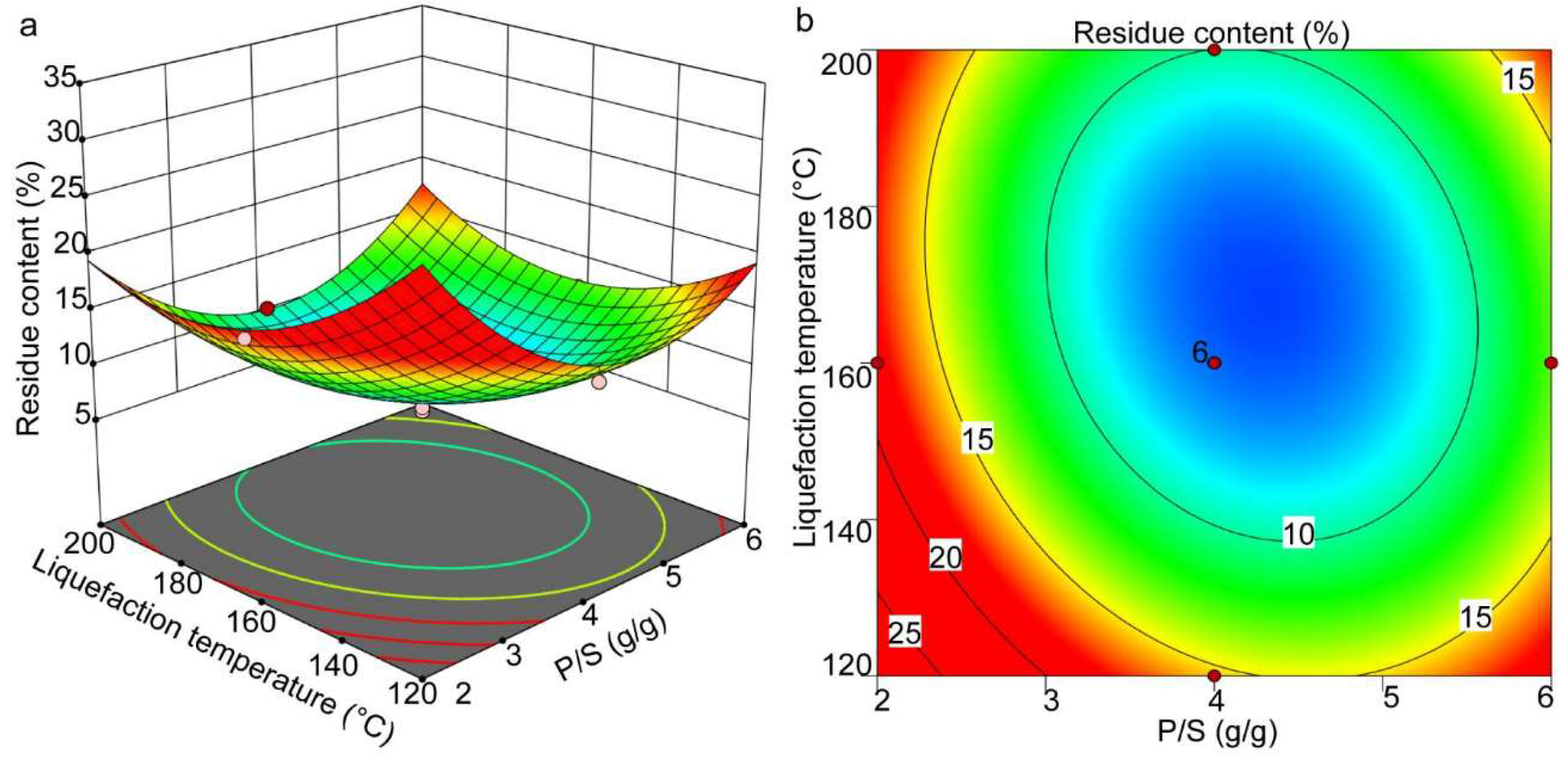
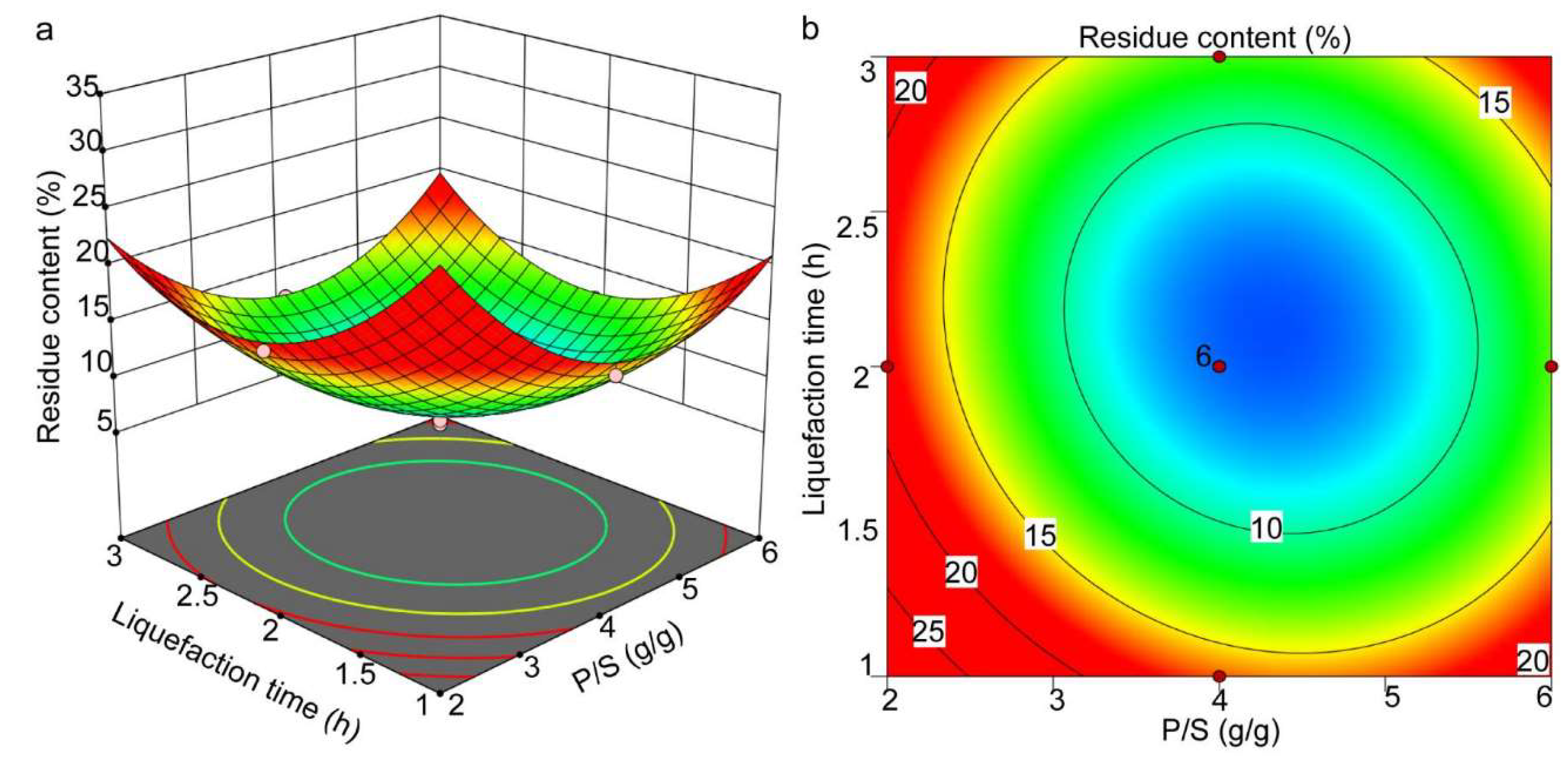
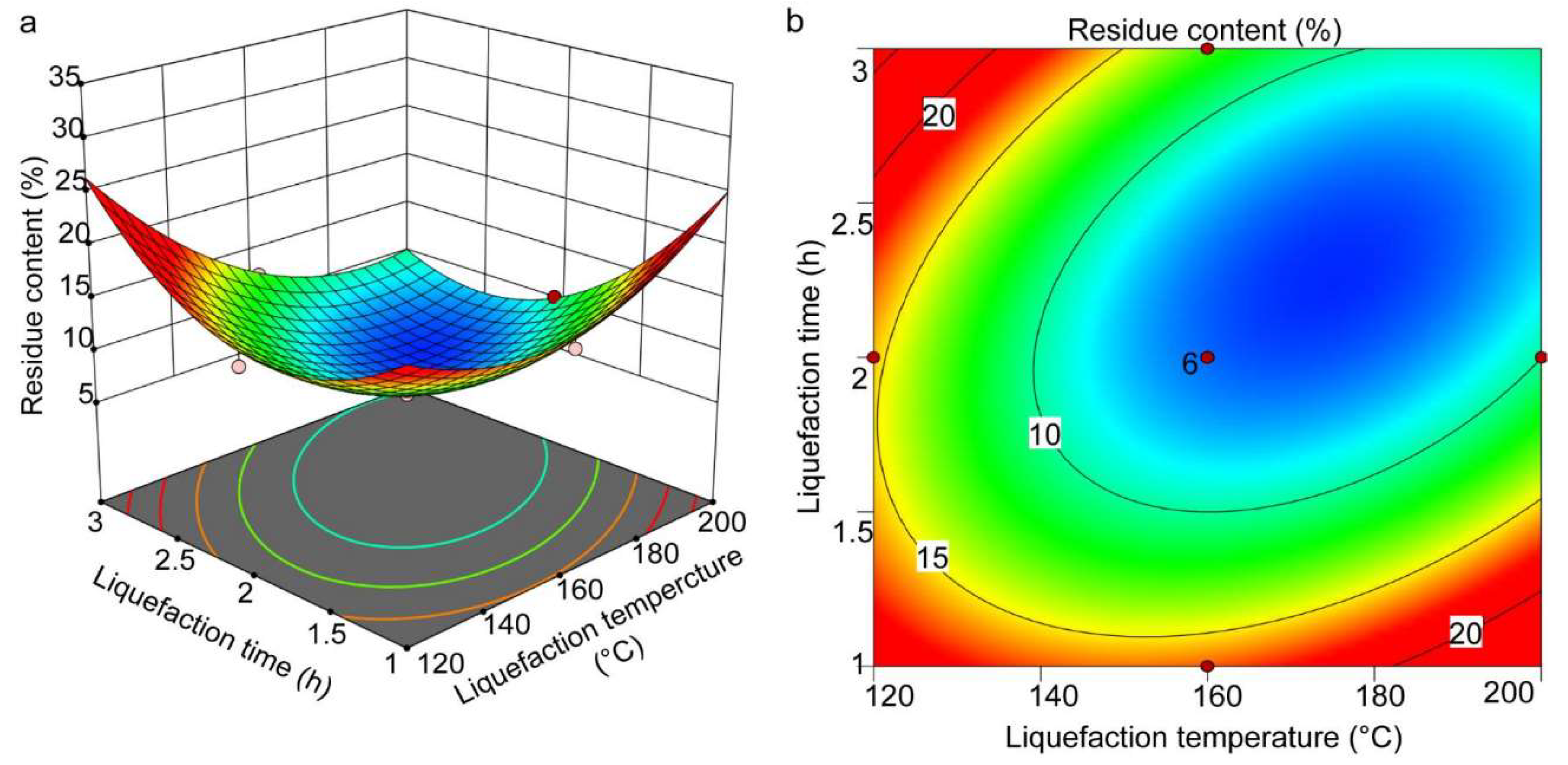
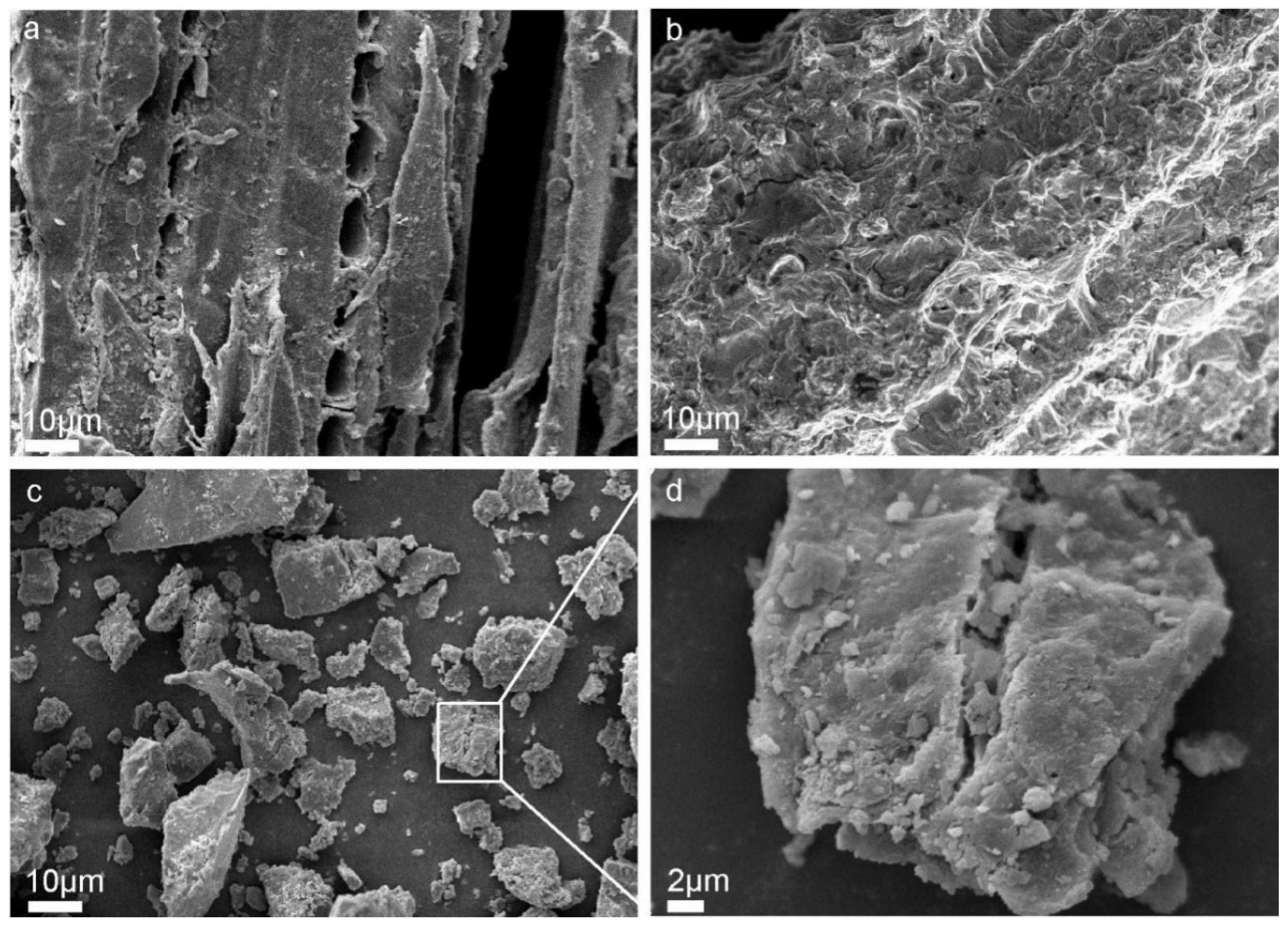

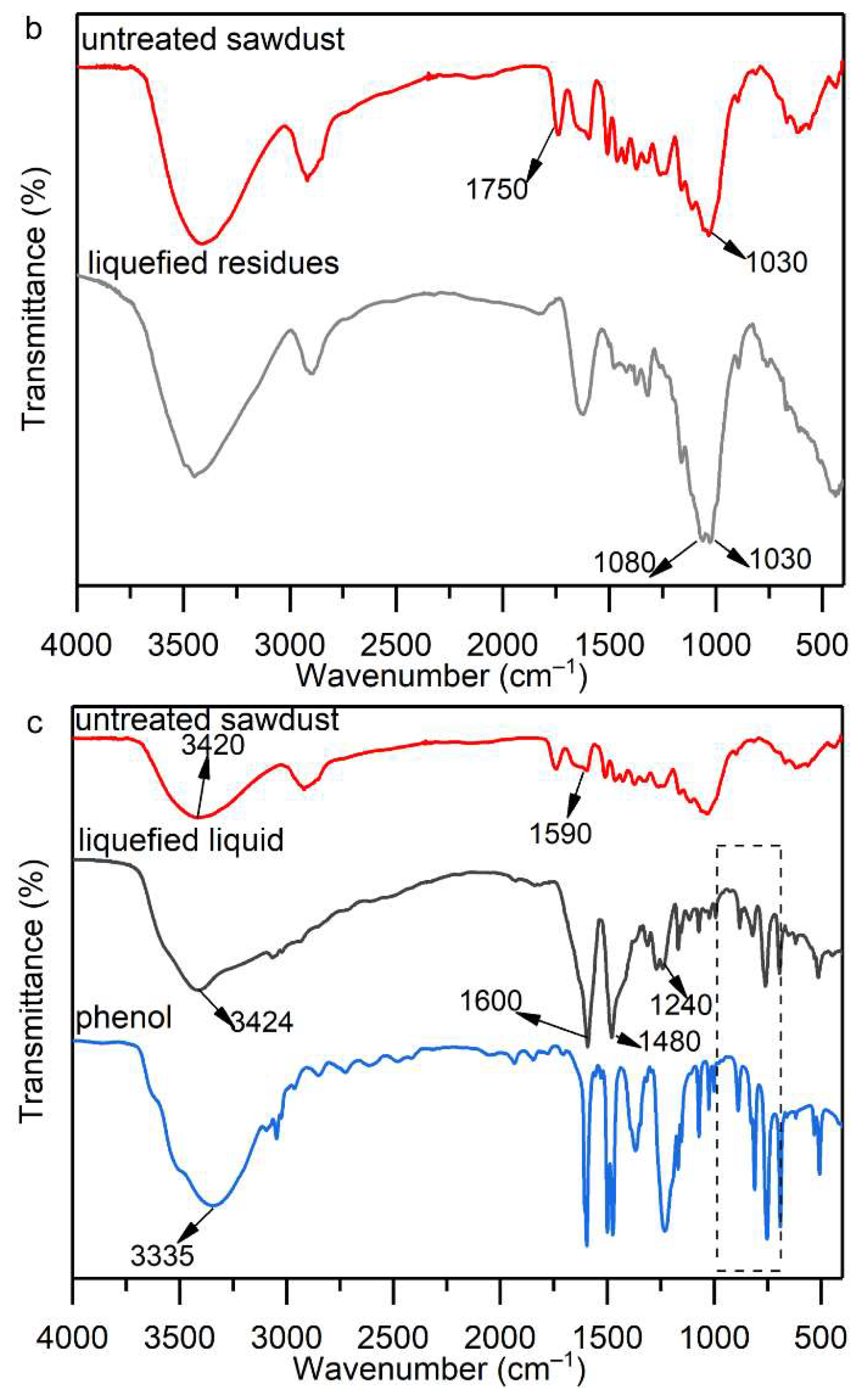
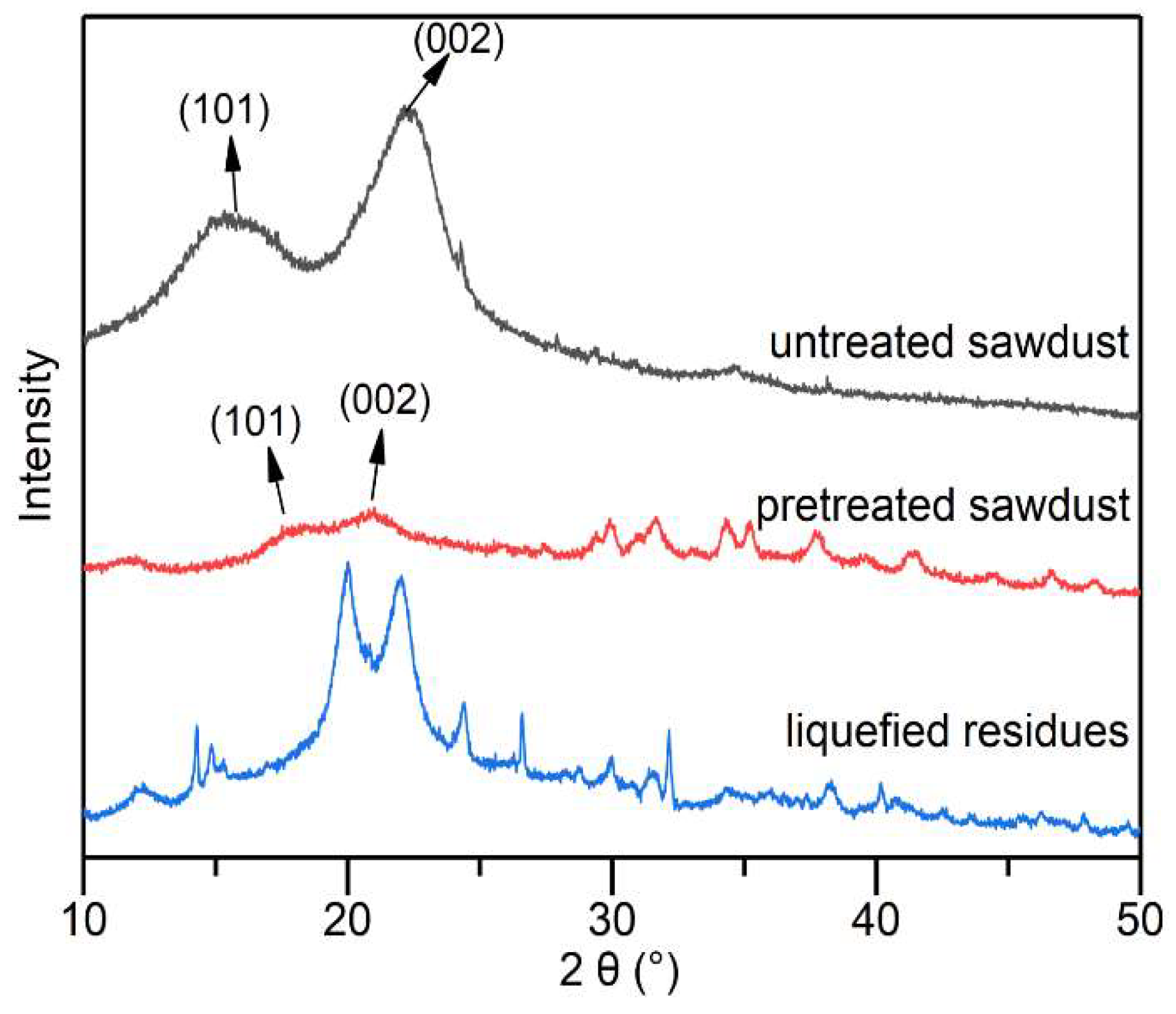
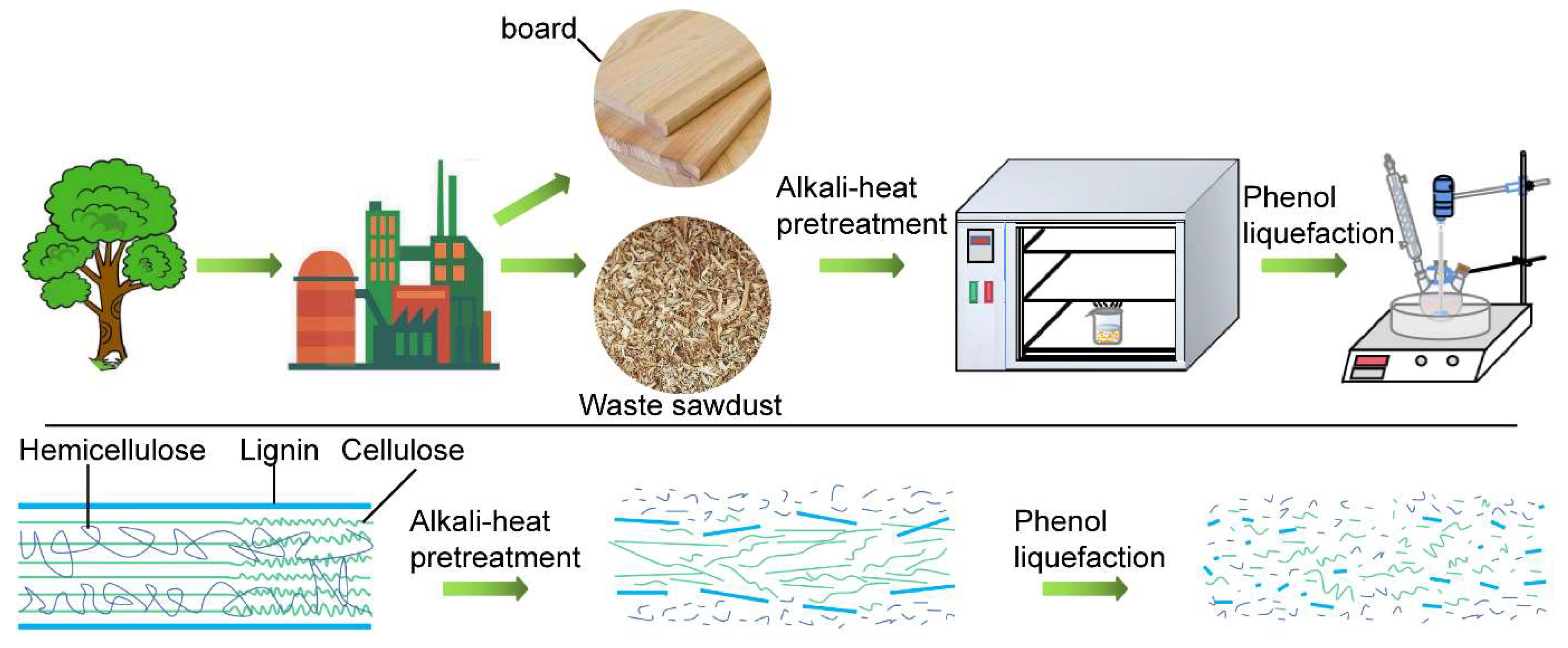
| Factors | ||||
|---|---|---|---|---|
| Order | Mass Ratio of Phenol to Pretreated Sawdust, P/S | Liquefaction Temperature, T (°C) | Liquefaction Time, t (h) | Residual Content, R (%) |
| 1 | 3 | 140 | 1.5 | 17.13 |
| 2 | 5 | 140 | 1.5 | 12.55 |
| 3 | 3 | 180 | 1.5 | 15.44 |
| 4 | 5 | 180 | 1.5 | 12.61 |
| 5 | 3 | 140 | 2.5 | 16.62 |
| 6 | 5 | 140 | 2.5 | 13.36 |
| 7 | 3 | 180 | 2.5 | 9.38 |
| 8 | 5 | 180 | 2.5 | 8.22 |
| 9 | 2 | 160 | 2 | 17.8 |
| 10 | 6 | 160 | 2 | 12.23 |
| 11 | 4 | 120 | 2 | 14.11 |
| 12 | 4 | 200 | 2 | 10.09 |
| 13 | 4 | 160 | 1 | 15.72 |
| 14 | 4 | 160 | 3 | 12.36 |
| 15 | 4 | 160 | 2 | 7.58 |
| 16 | 4 | 160 | 2 | 7.35 |
| 17 | 4 | 160 | 2 | 7.81 |
| 18 | 4 | 160 | 2 | 6.28 |
| 19 | 4 | 160 | 2 | 5.78 |
| 20 | 4 | 160 | 2 | 6.12 |
| Source | Sum of Squares | df | Mean Square | F Value | p Value | |
|---|---|---|---|---|---|---|
| Model | 284.38 | 9 | 31.60 | 24.91 | <0.0001 | significant |
| A | 32.98 | 1 | 32.98 | 26.00 | 0.0005 | |
| B | 30.39 | 1 | 30.39 | 23.96 | 0.0006 | |
| C | 17.79 | 1 | 17.79 | 14.02 | 0.0038 | |
| AB | 1.85 | 1 | 1.85 | 1.46 | 0.2546 | |
| AC | 1.12 | 1 | 1.12 | 0.8811 | 0.3700 | |
| BC | 14.45 | 1 | 14.45 | 11.39 | 0.0071 | |
| A2 | 116.78 | 1 | 116.78 | 92.07 | <0.0001 | |
| B2 | 51.15 | 1 | 51.15 | 40.33 | <0.0001 | |
| C2 | 91.85 | 1 | 91.85 | 72.42 | <0.0001 | |
| Residual | 12.68 | 10 | 1.27 | |||
| Lack of fit | 8.98 | 5 | 1.80 | 2.43 | 0.1765 | not significant |
| Pure error | 3.70 | 5 | 0.7404 | |||
| Cor total | 297.06 | 19 |
| Polymer Mass Fraction (%) | Element Mass Fraction (%) | Ash (%) | ||||||
|---|---|---|---|---|---|---|---|---|
| Cellulose | Hemicellulose | Klason Lignin | C | H | O | S | N | |
| 42.11 | 24.32 | 28.06 | 46.77 | 5.97 | 46.52 | 0.00 | 1.01 | 1.6 |
| Variables | Level | |||||
|---|---|---|---|---|---|---|
| Code | −2 | −1 | 0 | 1 | 2 | |
| Mass ratio of phenol to pretreated sawdust, P/S | A | 2 | 3 | 4 | 5 | 6 |
| Liquefaction temperature, T (°C) | B | 120 | 140 | 160 | 180 | 200 |
| Liquefaction time, t (h) | C | 1 | 1.5 | 2 | 2.5 | 3 |
Publisher’s Note: MDPI stays neutral with regard to jurisdictional claims in published maps and institutional affiliations. |
© 2022 by the authors. Licensee MDPI, Basel, Switzerland. This article is an open access article distributed under the terms and conditions of the Creative Commons Attribution (CC BY) license (https://creativecommons.org/licenses/by/4.0/).
Share and Cite
Lv, S.; Lin, X.; Gao, Z.; Hou, X.; Zhou, H.; Sun, J. Phenol Liquefaction of Waste Sawdust Pretreated by Sodium Hydroxide: Optimization of Parameters Using Response Surface Methodology. Molecules 2022, 27, 7880. https://doi.org/10.3390/molecules27227880
Lv S, Lin X, Gao Z, Hou X, Zhou H, Sun J. Phenol Liquefaction of Waste Sawdust Pretreated by Sodium Hydroxide: Optimization of Parameters Using Response Surface Methodology. Molecules. 2022; 27(22):7880. https://doi.org/10.3390/molecules27227880
Chicago/Turabian StyleLv, Shihao, Xiaoli Lin, Zhenzhong Gao, Xianfeng Hou, Haiyang Zhou, and Jin Sun. 2022. "Phenol Liquefaction of Waste Sawdust Pretreated by Sodium Hydroxide: Optimization of Parameters Using Response Surface Methodology" Molecules 27, no. 22: 7880. https://doi.org/10.3390/molecules27227880






